Langston Hughes in Reno
an annotated timeline based on Hughes’ 1934 daybook
I had always wanted to see Reno so, being near the Cali-Nev border, I decided to go there.
–Langston Hughes, I Wonder as I Wander
Langston Hughes’ explanation of why he came to Reno in September 1934 is simplistic, and none of his biographers seems to have bought it. He clearly wanted–and needed–an extended retreat from the distractions of his active social life and political activism in Carmel-by-the-Sea, in a place where he could live cheaply (he was virtually broke), but more immediately, he needed to feel safe from the vigilantes who’d threatened him there. He hoped to find both in Reno, which he enjoyed so much on a scouting trip that he began making plans once he returned to California for an extended Reno stay.

Noel Sullivan
When Hughes came to Reno, he had been enjoying the patronage of Noël Sullivan, whose palatial San Francisco home was a literary and cultural hub. Sullivan gave Hughes the use of his cottage at Carmel-by-the-Sea, complete with a cook and secretary, for the year preceding his Reno time. Among the most energetic periods of Hughes’ life, it was a year marked by a flourish of creativity that ended in Reno upon learning of his father’s untimely death, in Mexico.
Hughes drew stark contrasts between two classes of people in Reno:
There were hobo jungles along the railroad tracks outside the town, and stacks of silver dollars on the gambling tables inside the town . . .
Everybody in America was looking for work then; everybody moving from one place to another in search of a job. People who lived in the west were hoboing on trains to the east because they heard there were jobs out there. Sometimes they wouldn’t get any farther than Reno, whichever way they were going, and as none of them had any money they’d build thsee big fires near the railroad tracks, outside the town, and they’d just collected around these fires until they could make enough money at odd jobs to move farther on their way. . .
That’s a basic situation for two of his most important short stories, both of which use Reno for their settings: “Slice ’em Down” and “On the Road.”
Although remembered today most often as a poet, Hughes in the early 1930s was among the foremost American short story writers at a time when the form was dominant in magazine publishing. He had become a serious short story writer after reading D.H. Lawrence during a 1933 stay in Russia, and completing his first collection of stories was among many of his 1934 projects. He came to Reno as the celebrated author of that story collection, The Ways of White Folks, published in May 1934 by Knopf, the premier American literary publishing house. Arnold Rampersad, the principal Hughes biographer, said of it: “With this collection, Hughes repeated in the short story the feat he had already accomplished both in poetry and in the novel; he set a new standard of excellence for Black writers.”
“Slice ’em Down” and “On the Road” were both published in the new American magazine, Esquire, which had launched in September 1933; it introduced Hughes as “the brilliant young Negro author.” Hughes’ agent, Maxim Lieber, represented several of the most popular American writers, including Ernest Hemingway, John Dos Passos, Dashiell Hammett, and Erskine Caldwell, all published in early Esquire, which in the two years surrounding Hughes’ Reno visit would publish five of his stories and several of his poems.

“Slice ’em Down” illustration by Eric Lundgren. Esquire 1936.
Although both stories use Reno settings and characters, “Slice ’em Down” is more direct and representationally literal. Its principal action occurs in a club that Hughes describes in precise and atmospheric detail. It even employs Hughes’ own “late October evening” into a scene likely based on the “colored club” he’s introduced to during his first week in Reno; it’s one of the first places he returns to after coming back to Reno for his extended stay. That club, identified by Alicia Barber as likely the Dixie Club, also known as the Dixie Social Club, at 218 East Douglas Alley, is the most important of the Hughes-related literary locations in Reno because of its use as the primary setting in “Slice ’em Down,” which was first published in Esquire in 1936. Hughes notes several visits to the club in his daybook.
It begins:
In Reno, among the colored folks of the town, there are two main social classes: those who came to the city on a freight train, and those who didn’t. . .
The time, Hughes writes:
Saturday night in Reno. Back alley Reno. Colored Reno by the railroad tracks. . . Colored folks almost always live down by the railroad tracks.
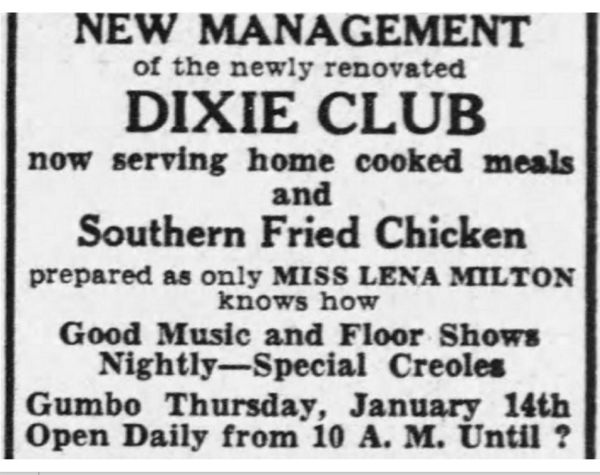
Dixie Club advertisement, 1937. Reno Evening Gazette 13 Jan. 1937. Courtesy of Alicia Barber and Renohistorical.org.
The place:
Packed and jammed, the Club, on a Saturday night. Little colored Club in Reno, six foot bar and dance floor no bigger than a dime. Old piano with the front wide open, strings showing and all the hammers of the notes, played by a little fat coal black man in shirt sleeves, a glass of gin by his side. A young yellow boy beating drums out of this world. Piano player singing as the dancers dance: ‘I’m going down de road. . . ‘
Maxim Lieber sold “Slice ’em Down” at a time when Hughes very much needed money; he re-wrote it with a comic ending and was delighted with the $150 it earned.
“On the Road,” on the other hand, is one of Hughes’ most daring and complicated stories. Like “Slice ’em Down,” its Depression-era Reno setting is palpable, but there’s no humor in it. On a snowy night, another Black bum rides the rails into Reno; homeless, he can find no shelter, even at a church. He begins to pound on the church doors only to awaken inside a jail cell, where he’s beaten by a cop. The story’s

Illustration for “On the Road” by Maurice Freed. Esquire January 1935.
Hughes said in the 1950s that the story was written in Reno in one sitting, “almost like a poem,” about “cold, hunger, a strange town at night whose permanent residents were not so cold and hungry, and a Black vagabond named Sargeant against white snow, cold people, hard doors, trying to go somewhere, but too tired and hungry to make it–hemmed in on the ground by the same people who hemmed Christ in by rigid rituals surrounding a man on a cross.” (Hughes’ own manuscripts show that “On the Road” was conceived in Reno and begun and finished in Carmel, where it it went through at least three drafts.)
The lack of aid offered Black Americans by the church and their persecution by police were themes often on Hughes’ mind. From Carmel, he had organized a big San Francisco benefit auction for the Scottsboro Boys defense fund, and he had already published a couple of his most incendiary poems. Many couldn’t get past the first line of his poem”Christ in Alabam,” which begins Christ is a nigger in Alabam,” The poem “One More ‘S’ in the U.S.A.” is part of a body of leftist and pro-Communist poetry that Hughes would come to downplay so much that by the time he wrote his first memoir, in 1939, he completely ignores vigilante threats as a cause for his having come to Reno in the first place.
Reno was good for Hughes’ literary inspiration as well as for his personal, recreational pursuits–it’s quite possible that he’d have come with or without any threats. He enjoyed gambling and nightclubs wherever he could find the opportunities, and he loved mixing with regular folks, as opposed to the literati and the fine folks of high society. And he must have heard from his sources that, unlike his circumstances in Carmel and San Francisco, Reno would offer opportunities to explore both worlds.
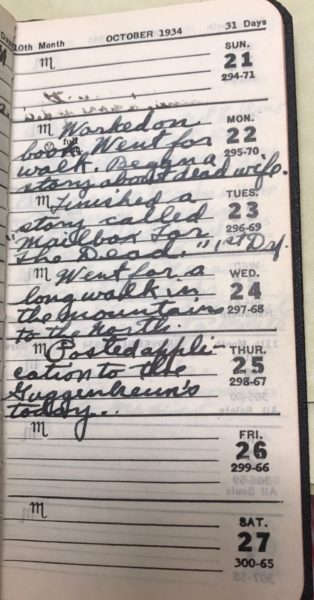
Langston Hughes’ daybook. Langston Hughes Papers. New Haven, CT. Beinecke Library, Yale U.
In addition to socializing at the club and gambling, he walked about the city, exploring its hobo camps along railroad tracks, and into surrounding hills and mountainsides. He doesn’t write much in his Reno daybook, just notes and outlines of his activities, but It’s easy to read between the lines of his Reno daybook that he had a good time in the city. It’s also clear from the may letters he wrote from Reno that he did a lot of writing, both correspondence and creative.
Rampersad suggests Hughes went to Reno anonymously on a whim, but it seems the choice to go there was much more intentional and arose out of a combination of events, acquaintances, and opportunities. It was not unusual for Hughes to register in rooming houses and hotels as James Hughes, his father’s name, but also Langston’s first name. It seems clear that Hughes knew sort of what to expect in Reno, and he also seems to have had enough contacts and references from those contacts that anonymity would have been impossible, even had he wanted it. By the time he comes back to town, for the planned extended stay, he’s clearly let others know where he’ll be.
Hughes completed as many as a dozen stories while in Reno; except for “Slice em Down” and “On the Road,” those he wrote as “Negro stories” were based on ideas and situations that preceded his Reno days. The idea for his “White stories,” using the pen name David Boatman seems to have originated and died while he was in Reno. Laurie Leach says there are five White stories but I can find evidence of only four. None have been previously published. Of them, “Mailbox for the Dead” is the most interesting, especially for Reno readers, for its use of Hillside Cemetery as a setting.
In addition to his stories, Hughes also writes about Reno in several letters, including one in which he describes his landlady, Helen Hubbard, and in a profile of one of the most prolific but unknown Black Nevada writers of the early 20th century, Oscar Hammonds, who wrote regular but unsigned weather articles, features, and summaries for statewide distribution from his Reno office. Hubbard and Hammonds share several connections, principally that of Bethel AME Church membership but also in their appearances together, usually with their spouses, (until she divorces hers) in Reno society news. They would have inhabited a different world from the nightlife Hughes enjoyed at gambling joints and clubs like the one which inspired “Slice ’em Down.”
Mrs. Hubbard and Oscar Hammonds were important figures in Reno’s Black community, but Ted Gilbert, a well-off White man not unlike Hughes’ patron Noël Sullivan, is perhaps the most significant of Hughes’ Reno connections, and I thank the excellent Reno-based historian Alicia Barber for having found out such good biographical details on his career as a concert violinist and also his Reno residency at the Nixon House. Hughes’ daybook entries from Carmel prior to his Reno days indicate that Gilbert was identified as a good contact for Hughes in Reno several weeks before he came to town for the first time.
It may be true, as Hughes writes, that he found Helen Hubbard’s boarding house on a recommendation from a porter, but living if just for a few weeks with someone as integral to Reno’s Black community as she was surely a boon to his enjoyment there. As an active member of Bethel AME, she’d have been perfect for introducing him to Oscar Hammonds, one of the early pillars, and financial supporters, of that church. Given Hughes’ frequent visits to Black churches wherever he traveled, it’s also easy to imagine that he enjoyed a service or two there.
Hughes came to Reno at the end of a hectic and dangerous year. He had helped organize agriculture worker strikes in late 1933, documented with another Carmel writer in a play, still never produced; led a national campaign to raise funds for the Scottsboro Boy’s defense; and written regularly for Communist magazines . As the only Black in Carmel’s John Reed Club, he was one of the reasons White citizens there had felt so threatened that they organized an American Legion. Hughes was a frequent target, and it was especially galling to some that he could be seen publicly with White women. On August 30, he had been attacked yet again by the Carmel Pine Cone as a Communist and threat to American decency; a friend had already warned him that his life was in danger. He left town to let things cool down, with Reno his destination.
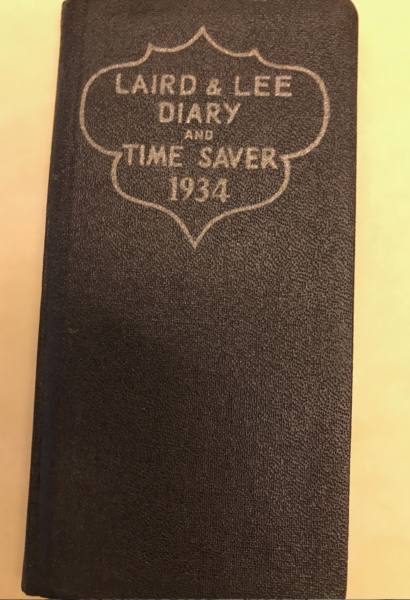
Langston Hughes Papers, New Haven, CT: Beinicke Library, Yale U.
In this timeline below, all italicized text is from Hughes’ 1934 daybook, daybook given to him as a 1933 Christmas gift
September 1934
Sept 1 [Saturday]
We leave for Echo Lake. Stop at Cathedral Oaks ? to hear Barabas read for Tarah’s birthday. Dinner at the Cats / Cato.
• “We” is Hughes, Noël Sullivan, and the actress Elsie Arden, and they’re going to a lake home owned by Ernestine Black, a San Francisco journalist and early suffragist. Little known today, Arden “was like a north wind, but benign. She had a most beautiful singing voice, a most beautiful speaking voice. She was a big woman, but she was a vroman of beauty, a wit, learned, uninhibited.”
–Lehman, Benjamin. “Recollections and reminiscences of life in the Bay Area from 1920 onward : oral history transcript / and related material, 1964-1969.” Intv. by Suzanne B. Riess. University of California Regional Oral History Office. 1969. Internetarchive.org. 2 Mar. 2025.
Sept 2
To Ernestine [Black’s] on Echo Lake. Slept under the stars. Can feel the altitude 7620.
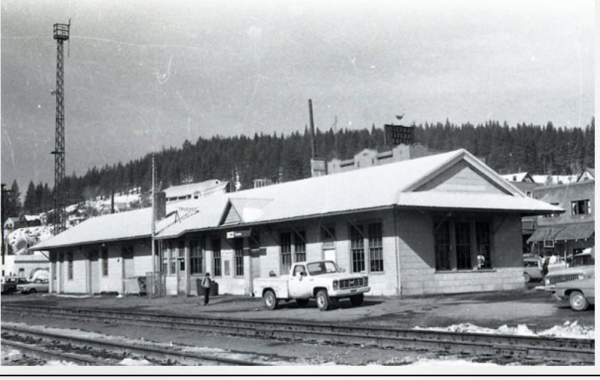
Truckee train station 1940. Truckee-Donner Historical Society.
Sept 3
Rowed and swam in lake. Went to see [BLANK SPACE] getting divorce in Nevada. On to Truckee.
Sept 4
Noël goes to SF. I leave on 5:55 for Reno. Stop at Mrs. Hubard [sic], 521 Elko Street.
• Helen Hubbard, Hughes’ landlady while he called Reno home, had been active in Reno’s Black social and religious activities since marrying Camilus Hubbard in April 1923; the Chicago Defender identified her as Helen Taylor of Kansas City, and he of Los Angeles. They took up residence on University Avenue and counted in their social circle Oscar H. Hammond (the weatherman whom Hughes will profile for the Defender) and his wife. The Hubbards hosted a bridge party “till a late hour” in January 1924–it concluded with a “dainty luncheon.” She was on the community sick list for most of March 1924 but by April was convalescing and with the Hammonds and others enjoyed a surprise birthday party for W.H. Nelson given by his wife: music, dancing, games, and whist prizes. The Hubbards and Hammonds were active in Bethel AME, and during that Spring, Helen Hubbard also hosted an after-church party to honor a couple visiting from Sacramento and gave a farewell party for Mr. & Mrs. George Jones, who were moving to California. The Hubbards and Hammonds enjoyed another “dainty luncheon” after “dancing till wee small hours” in May. In June, the two couples were part of large crowd who gathered at the AME reception hall, decorated with South American roses, to honor of Mrs. S.A. Wright, past matron and grand prelate of the Order of Eastern Stars, California. Mrs. W.H. Nelson, soloist, was accompanied by Mrs. James Daniels on piano for a recital that was followed by dancing and games until late, and then “an elaborate luncheon.” She had a birthday party for herself on October 20, with dancing, progressive whist, and at midnight “an elaborate 3-course luncheon.” The Hammonds, of course, were among the two dozen guests.
Camilus M. Hubbard, a porter at the Overland Hotel, was shot in the neck “by a Southern white man” in August 1922; the local NAACP, organized in 1919, became part of the prosecution, and J.S. Parks was eventually convicted of shooting with intent to kill in the incident, which had involved an allegedly drunken Parks losing the key to his hotel room.
Helen Hubbard sued Camilus for divorce in 1926 [“Suits Filed” Reno Gazette May 1, 1926: 8]; he appears to have remained at their 309 University Avenue residence; she moved to 521 Elko Street where she began operating a boarding house and is identified as a maid in the 1932 Reno City Directory. It was news in the Defender that she hosted the “prominent beautician of Los Angeles, Miss Carroll” that year.
She was elected secretary of the Colored Women’s Unity Club in 1927 (“Election of Officers,” Nevada State-Journal 13 Feb. 1927)
The Chicago Defender has no regular Reno correspondent from November 1924 – February 1930, but at that point, Helen Hubbard resumes her role as an often mentioned participant in Reno’s Black cultural life. Usually identified as “Mrs. Helen Hubbard,” she and the Hammonds attend lots of parties and take the occasional excursion to Sacramento.
Alicia Barber indicates that Helen Hubbard rented the house on Elko Street where Hughes boarded. Barber also located several local press accounts that establish some of the club’s history.
Sept 5
Several fellows, porters, etc, batch here. I go in with them on board.
• Hughes’ letter to Noel Sullivan, written soon after his Reno arrival, brims with excitement in its detail. His charming description of the landlady and her boarding house he’ll use as a home address for nine days and again for six weeks in October and November has been re-printed from this letter several times.
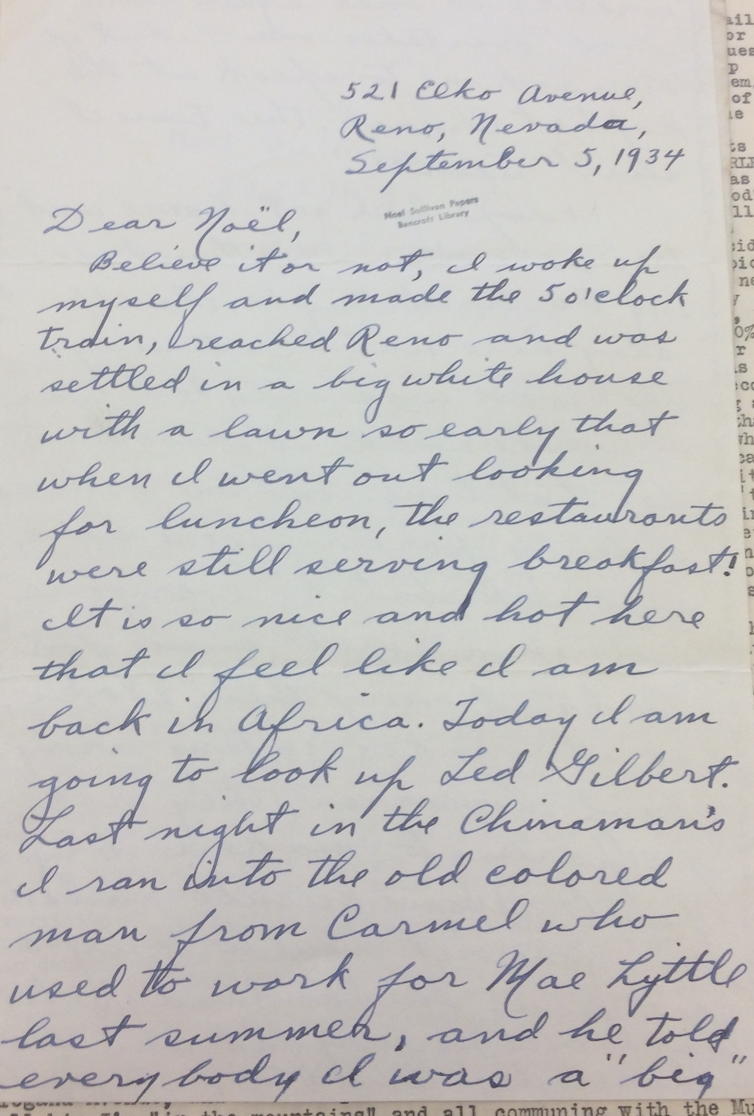

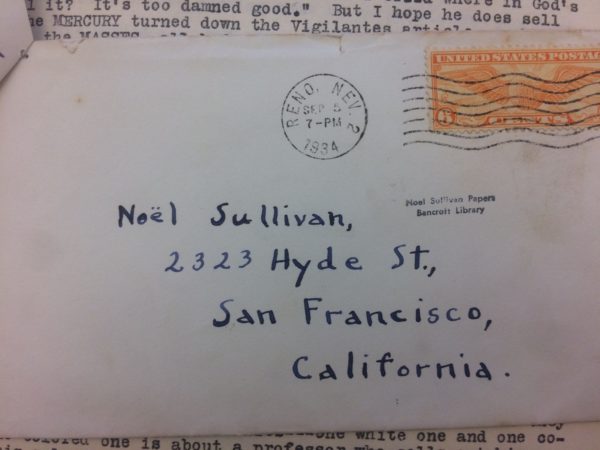
Noël Sullivan Papers. Berkeley, CA. Bancroft Library. U of California.

Noël Sullivan’s home, 2323 Hyde Street, San Francisco
Sept 6
Got in touch with Ted Gilbert at the old Nixon House. Won 2.00 at Chinaman’s.
• Alicia Barber found that Gilbert was a guest with Dan Kirkuff at the George S. Nixon Mansion, 631 California Avenue in Reno, and that Gilbert was well-known as a concert violinist and teacher. Originally from Massachusetts, he was featured in the society pages several times while he lived in Reno. By 1936, he had moved to Los Angeles with Kirkhuff, who was an architect. Hughes met a Jack Gilbert of Reno while staying in Carmel-by-the-Sea. It seems likely, as Alicia Barber suggests. that Hughes and Gilbert had been acquainted in New York. The relationship between Jack Gilbert and Ted Gilbert is not clear.
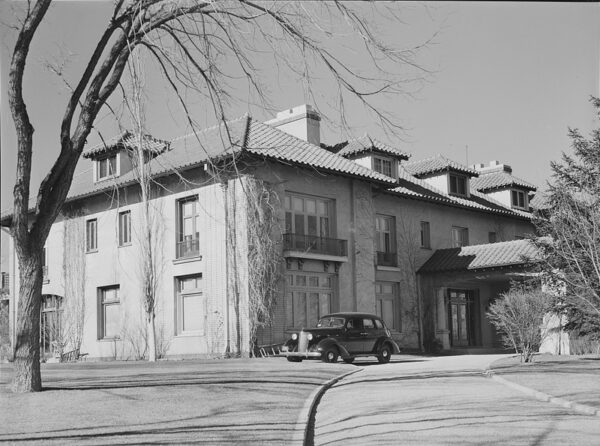
The Nixon House, 1940, photo by Arthur Rothstein for Farm Security Administration. Courtesy of US Library of Congress..
Sept 7
Had tea with Mr. Gilbert, Mrs. Willard (Union Trust Co.) and Miss Toohey of Washington. Also C—?
• 1933 & 1935 Reno City Directories, using “CD” to indicate “colored,” has Martin & Kath. Toohey at 545 University Avenue, as manager(s) of Butler Apartments. 1935 City Directory lists John M. Willard at 142 Virginia Avenue and Thomas H. Willard, a cook, at 29 E. Plaza, neither with a wife.
Sept 8
Went to Pyramid Lake with same party from picnic, Back to lose 3.00 at Chinaman’s.

Photo by Langston Hughes. Noel Sullivan Papers. Berkeley, CA. Bancroft Library, UC-Berkeley.
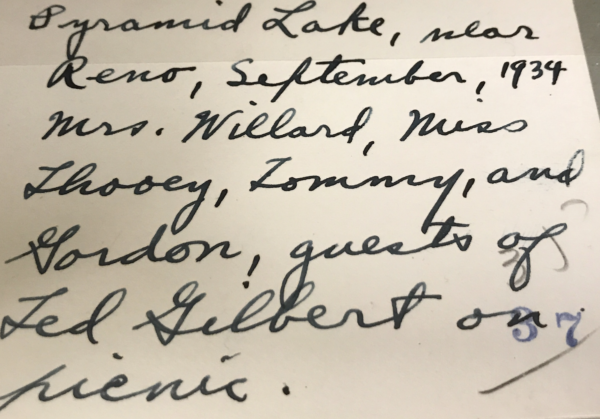
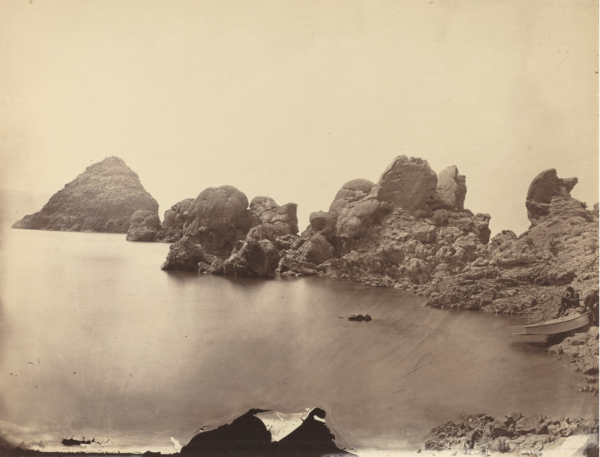
Tula Domes, Pyramid Lake by Timothy H. O’Sullivan, Jan. 1, 1867. Library of Congress.
• Timothy H. O’ Sullivan and his early photography was re-discovered in the 20th century by Ansel Adams, who was then living in Carmel. O’Sullivan’s exploration of Pyramid Lake as part of the U.S. government’s Geological Exploration of the Fortieth Parallel is detailed in Robert Sullivan’s 2024 book Double Exposure. He writes of the photo above: “It’s a captivating and curious projection of tiny islands running off into the distance, the chain like a question mark, coaxing you to keep looking, beckoning toward a place you do not know, an edge of the world, or maybe another world. . . . It says, “You are now stepping onto these crazed rocks, out onto these fungal islands, landforms that appear as if–wait, are they alive?”
Sept 9
Lost 3 bucks at the Chinaman’s. To colored club with Garner.
• Hughes lost little time in finding two of his favorite Reno businesses. Alicia Barber has determined that “the Chinaman’s” was likely one of two Chinese-run gambling clubs operating in Reno in the fall of 1934: the Star Club, operated by Walter Tun in a basement at 137 Lake Street, and the Public Club, operated by Woo Sing at 223 Lake Street. The Star Club, south of Second Street, was in the “Chinese Quarter, ” where most Chinese-related businesses and residences were still located. Both clubs would have had keno and table games. Hughes clearly enjoyed spending time and money at one of these.

Kid Chocolate
Sept. 10. To the gym with Chocolate and Wilber. Kept time for the fighters.
• Kid Chocolate, who was one of the most popular Black boxers of his day, had neared the end of his impressive career by the time Hughes kept time for him at the Chestnut Street Gym, 246 Chestnut Street [now Arlington & the corner of Arlington & Commercial Row.] “Wilber” remains a mystery.
Originally a garage, it was converted into what was more commonly called the Chestnut Street Arena in 1931 and used primarily for boxing events. It was eventually absorbed by Reno Iron Works.
In August and September 1934, the gym hosted boxing and occasional wrestling matches on Friday nights. Kid Chocolate fought to draws twice in August; prior to his August 25 fight, the Nevada State-Journal notes that he’s “formerly of Reno.”

Courtesy of Alicia Barber
Chocolate fought 11 sanctioned bouts in 1934, with 8 wins, 2 losses, and a draw. When Hughes kept time for him, he would have been looking towards a November fight that he would win by knockout in New York. The arena hosted weekly boxing and wrestling matches, and Chocolate likely had matches in Reno, but it does not appear that all the fights staged at the Chesnut Street arena are part of Boxing.com’s extensive data base of fighters, fights, and arenas.
Chocolate, whose real name was Eligio Sardinias Montalvo, learned to box by studying film of three fights, including Jack Johnson’s win over Jim Jefferies on July 4, 1910, the biggest sporting event ever staged in Reno.
Also known as the Cuban Bon Bon, he was noted in the press for his extravagant nightlife as well as for his boxing skills. He won his first 51 bouts; some boxing historians believe his final record would have been much better, as good as 98-1, had he not been deprived of victories by prejudiced judges.
During the 1930s, boxing was the only major sport open to Black athletes, though Blacks often fought on under-cards against other Black fighters; championship bouts against White opponents were especially difficult to arrange. Chocolate was both a welterweight and light-weight champion.
Hughes met up with Chocolate and his mother and took their photos while visiting Cuba in 1927, near the beginning of Chocolate’s professional career, and again in New Orleans, and Hughes had plans for writing a screenplay based on Chocolate’s life and career.
Any screenplay based on Hughes in Reno would certainly include a scene or two of Kid Chocolate showing Hughes the city’s nightlife.
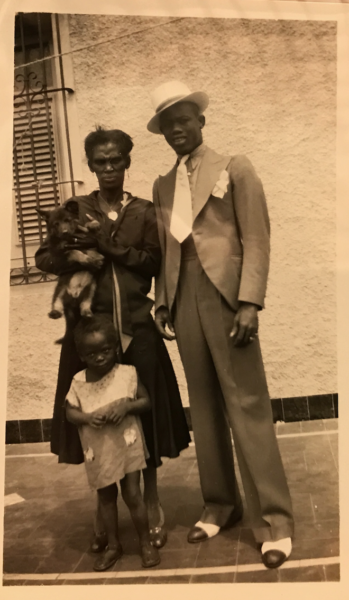
Kid Chocolate and his mother and perhaps his child, in Havana 1927. Photo by Langston Hughes. Langston Hughes Papers, New Haven, CT. Beinicke Library, Yale University.
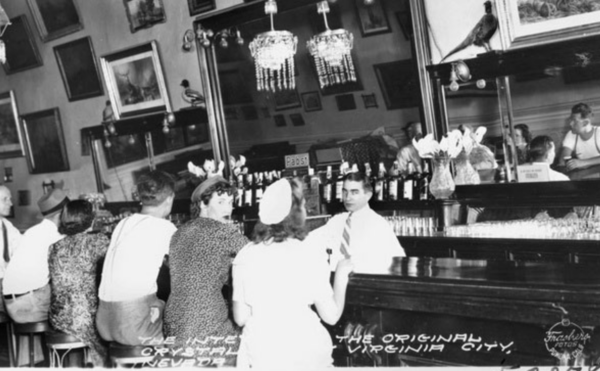
Crystal Bar, Virginia City, 1940. Online archive of California.
Sept 11
To Virginia City with Gordon, tour the old gold mines Crystal bar and opera house.
Sept 12
Everyone came to see me off at the airport. Swell flight over the mountains and into the sunset.
• “Everyone” would surely have included Ted Gilbert.
This was Hughes’ first time flying. Hubbard Airport was established in 1927; Charles Lindberg’s landing there helped publicize that it was open for business. (Skorupa, Susan. 29 Jne 2003. Reno Gazzette-Journal 1-2B.) Amelia Earhart’s 1931 stop en route to Sacramento preceded a 3-crash return trip back East (Cafferata, Patty. Reno Gazette-Journal, 10 June 2014: 3D)
For what was supposed to be a scouting excursion to Reno to see if he’d like it enough to return for work and play, Hughes seems to have created an impressive social circle in the few days he had in Reno, but his send-off at the airport is otherwise unmentioned.
Sept. 13 – Oct. 12 Hughes is in SF & Carmel-by-the-Sea
ADD A FEW DETAILS ON CARMEL CROWD/ SCENE that he returns to.
Sept 13 [in SF at Noel Sullivan’s house]
Telephoned Talla Mae, Dorothy, Gladys, Matt. Down to Carmel with Noel.
Sept 14
Spent the afternoon on beach with Marie, Rhys, Noël, Ella, Dan and others.
Sept 15
To Peter Pan Lodge at invitation of Mrs. Mathias to listen to Krishnamurti, amusing and abstract.
Sept 16
To Big Sur and above the fog with Douglas and Marie Smart, Constance Comago.
Sept 17
Worked all day sorting and packing. Wrote letters. Sybil and Vasher Anrkeeff down again to Peter Pan to hear Krishnamurti. This time better.
Sept 19
Paul Fleegal draws my portrait. Dorothy Erskine comes in for dinner.
Sept 20
Up at 6 and to city. Haircut. Early to bed and to sleep.
Sept 21
Roy typed for me all day on play and new poems. Dinner at Dorothy’s.
Sept 22
Spoke on my book at Paul Elder’s Gallery. Overflow crowd. Had to speak twice. Met Lillie Kerner and William Saroyan, supper with them. Out with Talla Mae in eve.
Sept 23
Constance Kamaga [Consuelo Kamanga] took my photo. To Carmel by train to see Elsie [Arden] & Ernestine [Black].
Sept 24
Burleigh, the pianist, in for dinner with Noel, Elsie Arden and Ernestine Ball [Black].
Sept 25
Up the Carmel Valley to dinner with Paul Flegel at Rancho San Carlos. Songs in the moonlight.
Sept 26
Worked on an article “Vigilantes Knock at My Door.” Sent off poems to Lieber.
Although written in Carmel and exclusively about tensions there that led him to fear for his life, this impassioned essay is important to Hughes’ Reno days because the threats revealed in it are what led him to seek out Reno during this time. It remains unpublished.

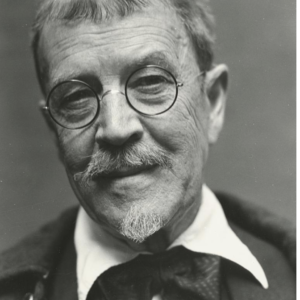
Lincoln Steffens
Sept 27
Found my account at bank overdraawn by 5.80. Went to see Ella and Steffy.
The renowned muckraker Lincoln Steffens and his wife, Ella Winter, were the stars of Carmel-by-the-Sea’s literary and leftist political scene. She and Hughes were especially close and they co-authored the unproduced play Blood in the Fields during the summer of 1934.
Sept 28
Pat off, so cooked my own dinner. Had two steaks. Noel comes from city.
Sept 29
Started a story “On the Road.” Worked on play. Got $13 check from the New Republic.
Sept 30
Up to Dr. Kocher’s for picnic with Noel and the Shorts. Read Saroyan outdoors.
Hughes first met the author William Saroyan at Hughes’ September 22 reading at Elder’s Gallery, San Francisco.
October 1934
Oct 4
Very early up to city. Went to dentist and home to bed. Slept 11 hours.
Oct 5
Roy came over to type. Worked all day on letters, early to bed.
Part of Hughes’ plan for that year involved such a heavy writing schedule that he’d need a secretary, who was secured through funds supplied by Sullivan. He began working for Hughes in January 1934. Roy Blackburn got the job: “handsome, brown-skinned, and 22 years old,” Blackburn told Rampersad that he arrived in Carmel on New Year’s day to apply: “I didn’t have an invitation, or even an address, but I had his box number. Those were hard times. I took the bus down from Oakland and went to the post office to find out where he lived.” [Rampersad 1: 284] Blackburn and Hughes signed a formal agreement for him to work for 6 months for room and board and 20% of the net income from “all stories, articles, and poems written in the following six months, exclusive of books published or plays sold.” He stayed much longer, finally leaving near the end of 1934 to attend college.
Oct 6
Letters all day. In evening to see John Pittman just back from New York and Atlanta.
Oct 7
Fan Jacksons come up from L.A. with plans to start a Negro theatre there.
Oct 8
Went to see Billy Justenias exhibit at Courvoiser. Met Albert Bender.
Oct 9
Worked on mail all day.
Oct 10
Went to see my proofs at Constance Kamaga’s. She gives me lovely photo of Lester, Marie Short’s maid.
Consuelo Kanaga was a prominent photographer noted for her portraits of African Americans. She was associated with Edward Weston and Ansel Adams in the 1930s and her work was part of the first f/64 show in 1932.
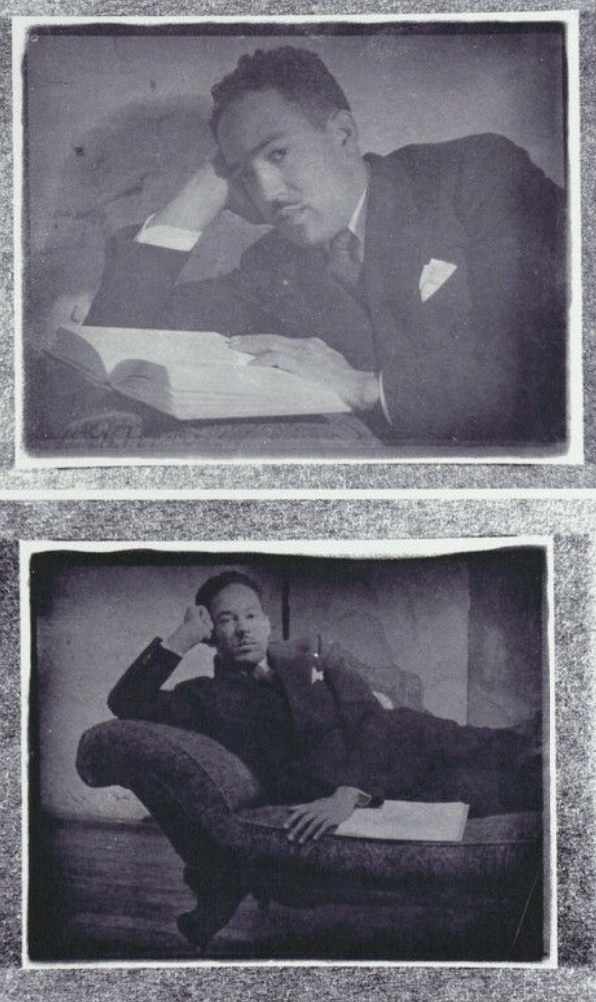
Two of Konaga’s Hughes portraits. Langston Hughes papers. New Haven, CT. Beinecke Library, Yale University.
Oct 11
To Berkeley with Noël to hear Ella Young’s lecture on the Gaels ? and the Tunics.
Ella Young was another of Hughes’ Carmel-by-the-Sea friends and political allies.
Oct 12
Wrote 18 letters. Packed. Elsie Arden leaves for New York, me for Reno.
Arden was another in Hughes’ wide social circle in Carmel-by-the-Sea.
Oct 13 – Hughes returns to Reno.
Oct 13
Arrive Reno in early morning. Win 1.50 at Chinaman’s. To colored club at night. Swell blues and jazz.
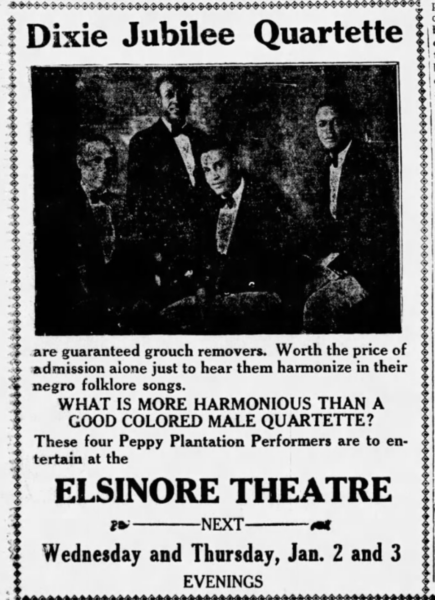
Alicia Barber located this add for a Jubilee Quartette performance in Salem, Oregon.
Oct 14
To Carson City with the Dixie Quartette. Fouche; Arnette Williams, 2 more of L.A.
• Based out of San Diego, the quartet included James Collins, 1st tenor; W.R. “Napoleon” Simpson, 2nd tenor; Aramis Fouche, baritone; and Arnett Williams, basso, who replaced Carroll Weaver after January 1932. In 1930, when they were Los Angeles-based, only Fouche and Simpson were with them. In December 1934, they performed in San Diego, also with Williams.
Williams and Hughes attended Lincoln University, where Williams was a football player. He married W.E.B. DuBois’ daughter, Yolanda, in 1931; they divorced soon after their child was born the next year. She had previously been married to the poet Countee Cullen.
–Ross, Albert F. “California News: San Diego” Chicago Defender . 8 Dec. 1934: 18.
—“California News.” California News: San Diego.” Chicago Defender. 9 Jan. 1932: 12.
—“California News: San Diego.” Chicago Defender. 11 Jan. 1930: 21.
–“DuBois’ Daughter Married to Student,” Chicago Defender 19 Sept. 1931: 15. ProQuest. 2 Mar. 2025.
Oct 15 – 21 [no entries]
Oct 22
Worked on book. Went for walk. Began on story about dead wife [which he’ll finish the net day]
Oct 23
Finished a story called “Mailbox for the Dead.” 1st draft. [also titled “Postal Box Love”]
“Mailbox for the Dead,” the best of Hughes’ “David Boatman” stories, uses a setting that’s likely Hillside Cemetery, located near the university of Nevada.. ADD BRIEF PLOT SUMMARy + cemetery excerpt from story.
Oct 24
Went for a long walk in the mountains to the north.
On October 24, Hughes also wrote to Noël Sullivan, “I think my real metier is protesting about something. . . “
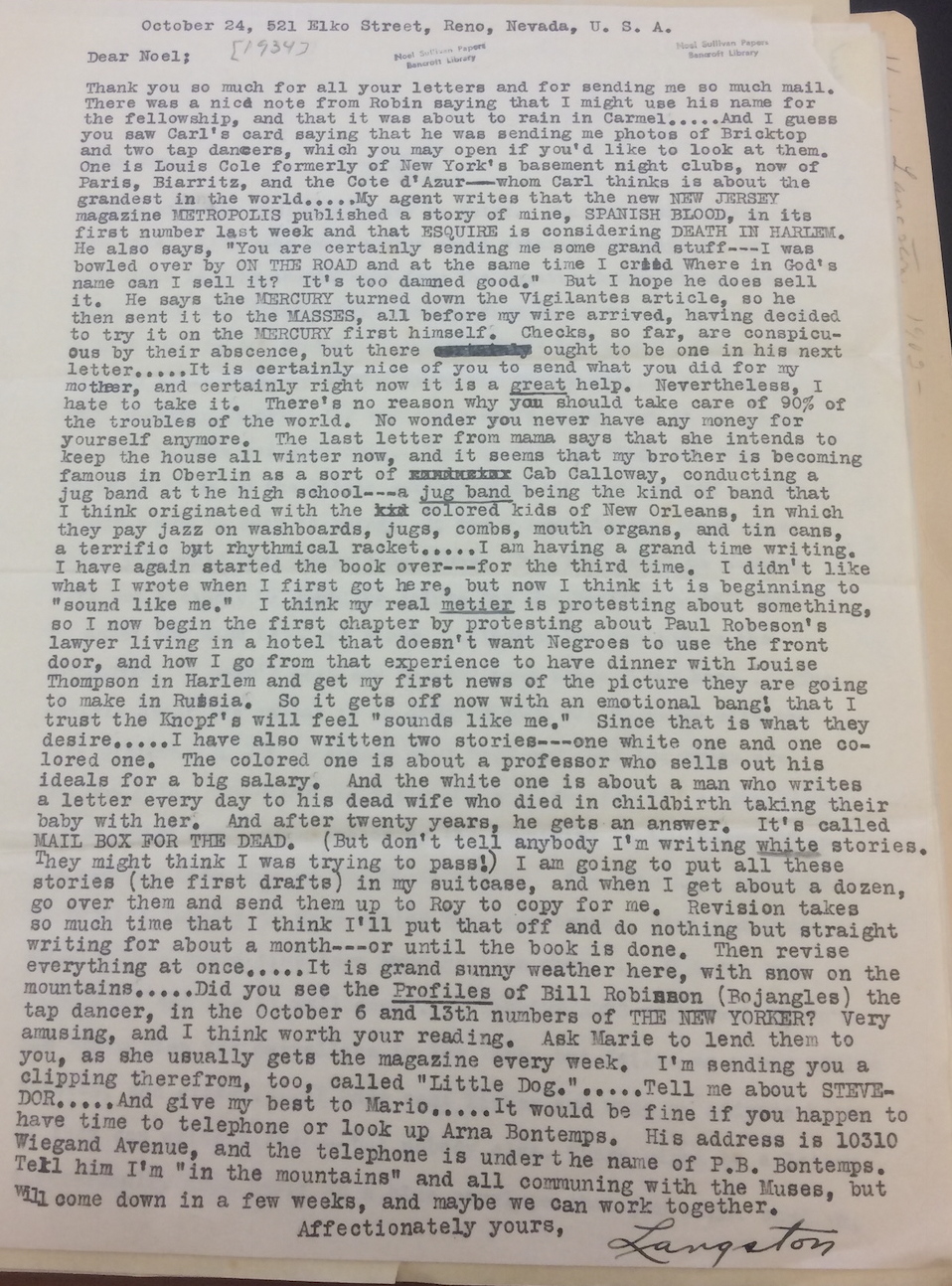
Noel Sullivan Papers Berkeley, CA.. Bancroft Library. U of California.
Oct 25
Posted application to the Guggenheim’s today.
Oct 26 -0-
Oct 27 -0-
Oct 29 -0- Hughes on this date writes to Noël Sullivan that “Reno is still amusing, but they are going to close up the little colored club, as they are not making enough money to keep it going. It was a grand little tough place where you could hear marvelous blues. Now there will be nothing left but a couple of gambling joints for the Race to go to. . . Almost every day I go climbing in the mountains to the North of us and you can look down on the whole valley. The mountains are full of rabbits jumping up from behind the sage brush. Tina and Greg [Sullivan’s dogs] would have a grand time running them down. . . “
“Peter” is a nickname for Ella Winter, Lincoln Steffen’s wife with whom Hughes was collaborating on a play about the agriculture worker strikes of 1933.
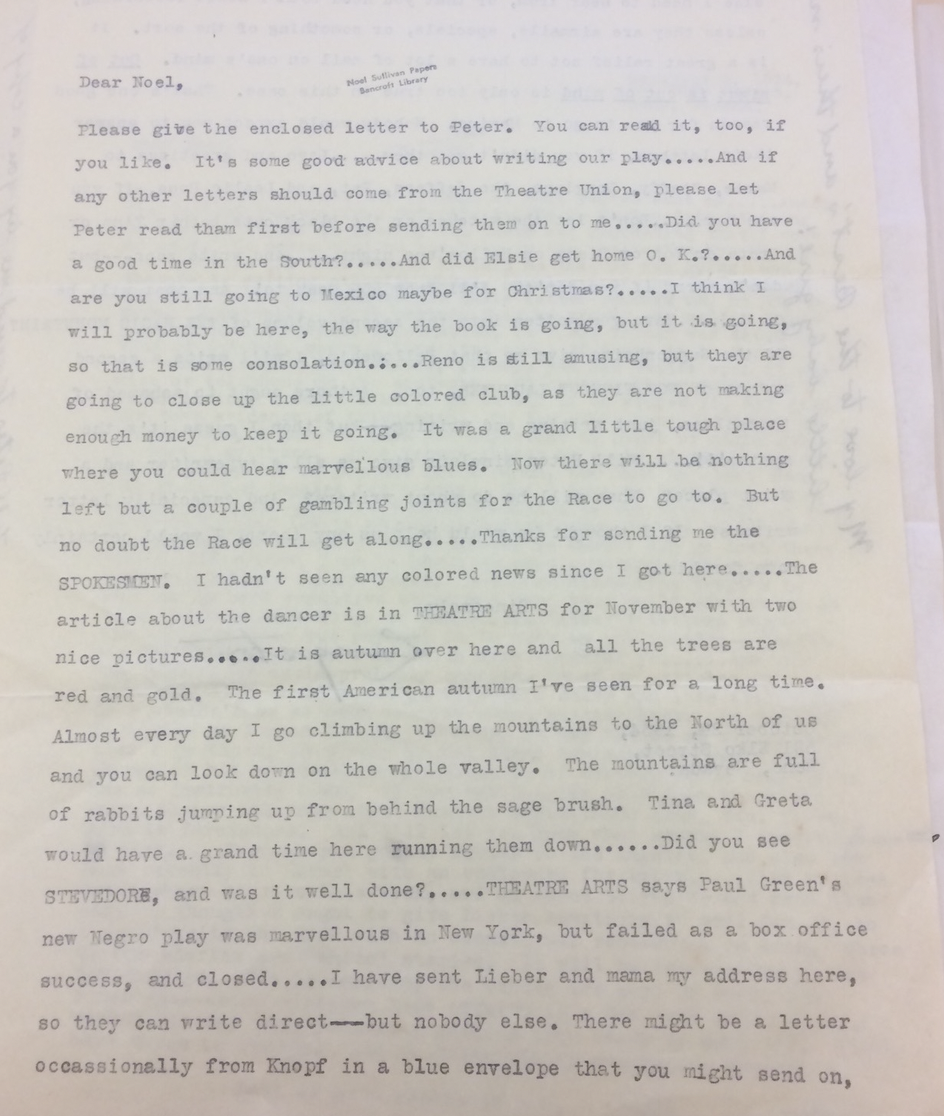
November 1934
Nov 3 -0-
[No entries] He writes to Lieber about his David Boatman stories and others “leaning mostly to the left–I have a half a dozen new stories all ready but for the copying wrote this letter to Maxim Lieber]
Nov 4 -0-
Nov 5
A letter forwarded to Reno from Dolores Patino dated Oct. 22 saying my father is very ill.
He also writes to Sullivan about his father’s condition, his finances (“only six dollars in the world”) and his work: “I’ve written seven new stories this week. I’m about to revise and send them off. . .”
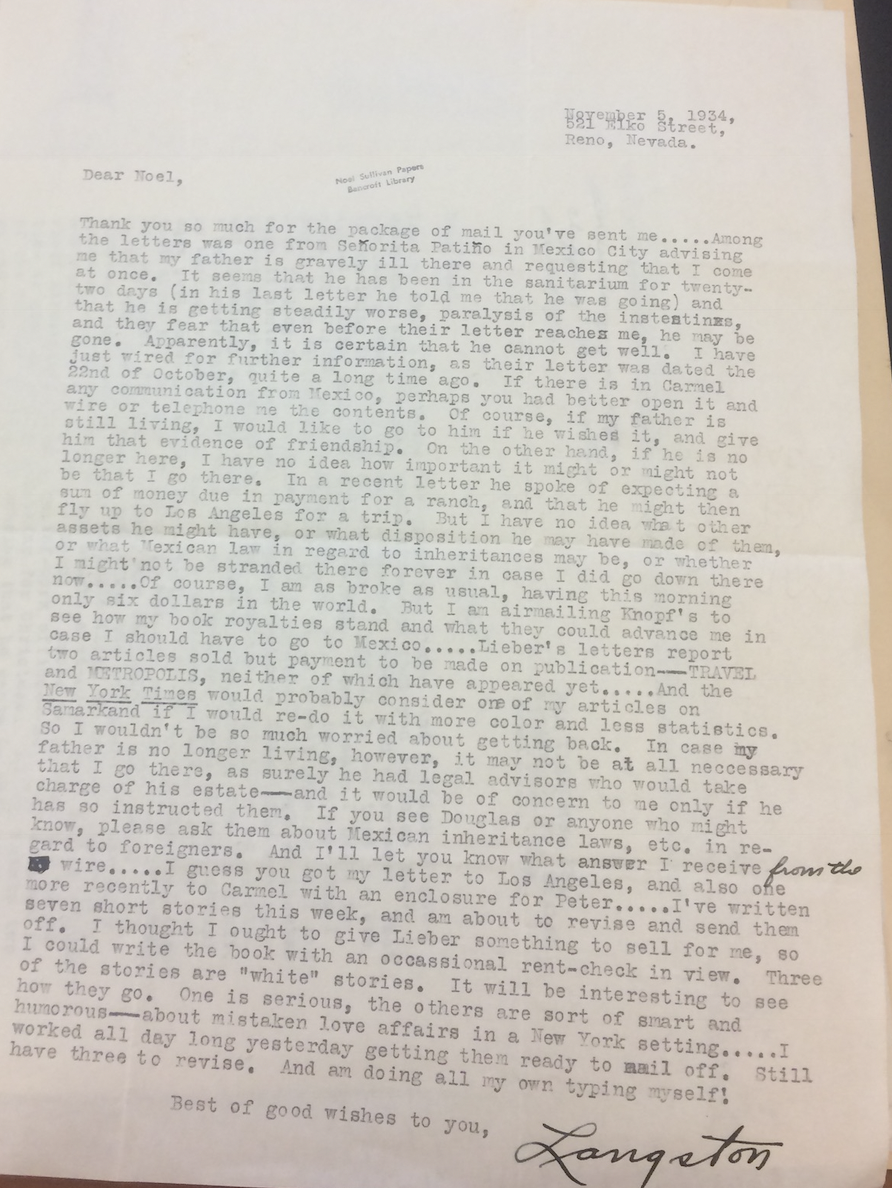
Noël Sullivan Papers. Berkeley, CA. Bancroft LIbrary, UC-Berkeley,
Nov 6
An answer to my wire of inquiring saying that he [his father] died on October 22nd.
Nov 7
Mailed off 4 Negro stories, Professor Tailor & Steward etc. Went to see Count of Monte Cristo. FIND AD from RENO GAZETTE
Nov 8
Won $2.50 at the Chinaman’s. Trying to raise money to go to Mexico.
Nov 9 -0-
Nov 10 -0-
Nov 11 -0-
Nov 12
Check for $100 received from Uncle John. Won $1.50 at Chinaman’s.
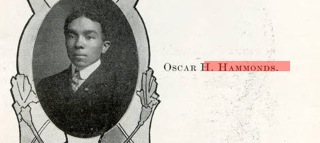
Hammonds high school portrait
Nov 13
Interviewed Oscar Hammonds, the colored weather man here.
Hughes’ profile of Hammonds was published in the Chicago Defender.
Oscar Hammonds was a prominent member of Reno’s AME Church, serving as its treasurer and an organizer of frequent special events. The church staged Ethiopia at the Bar of Justice several times in the early 1930s. Written by Edward McCoo, it was a popular play in Black communities throughout the United States and was staged by the general conference of the AME church in 1924. James Wells illustrated the concept for W.E.B. duBois’ The Crisis.

James L. Wells illustration for Ethiopia at the Bar of Justice. NYU.edu/lapis
The Reno productions were for integrated audiences and at least two of them had essentially the same cast, including Oscar Hammonds.

Oscar Hammonds is seated at center with the Reno cast of Ethiopia at the Bar of Justice
Hughes’ typescript for his profile of Oscar Hammonds:
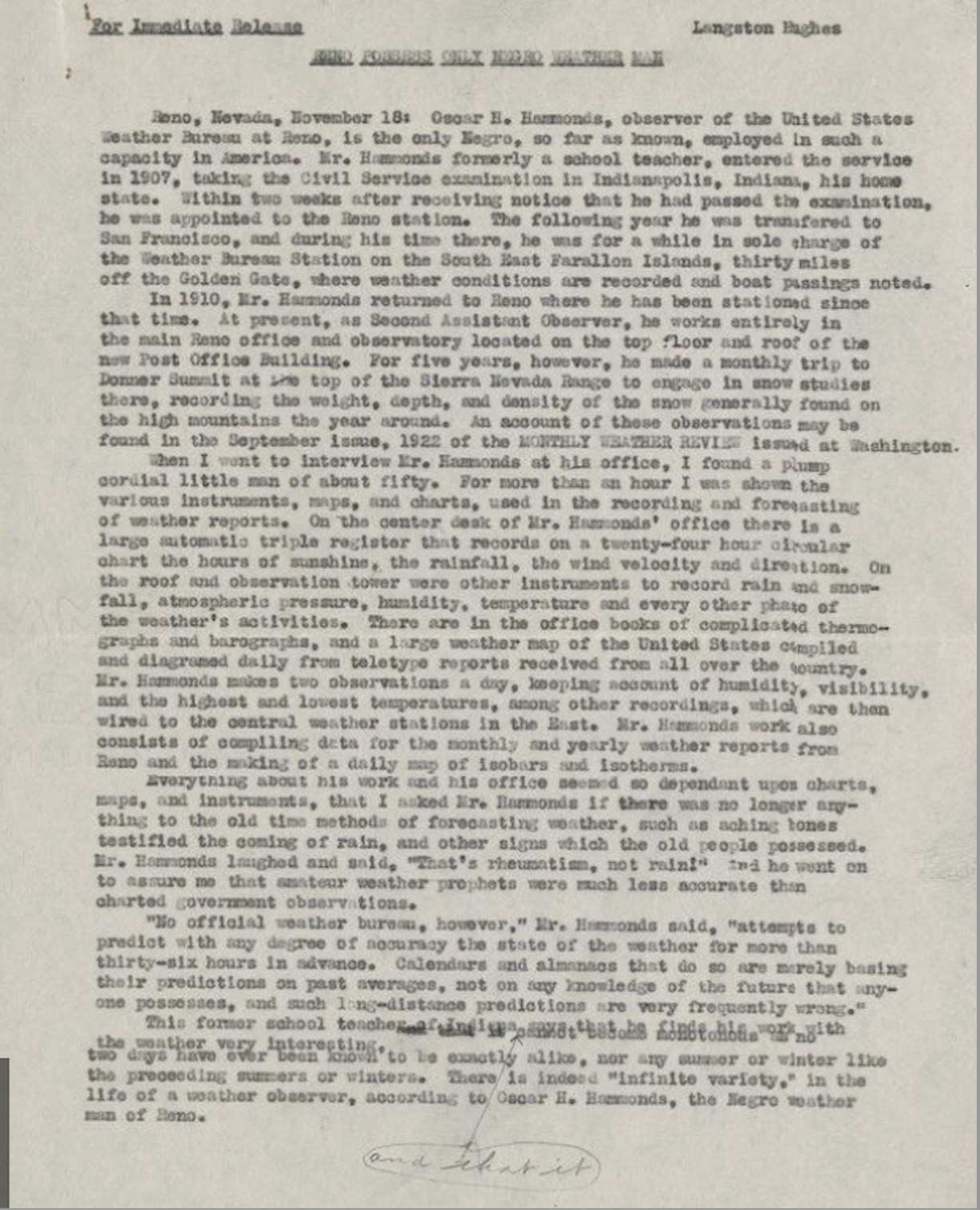
Langston Hughes Papers. New Haven, CT. Beinecke Library. Yale U.
The profile as it was published:
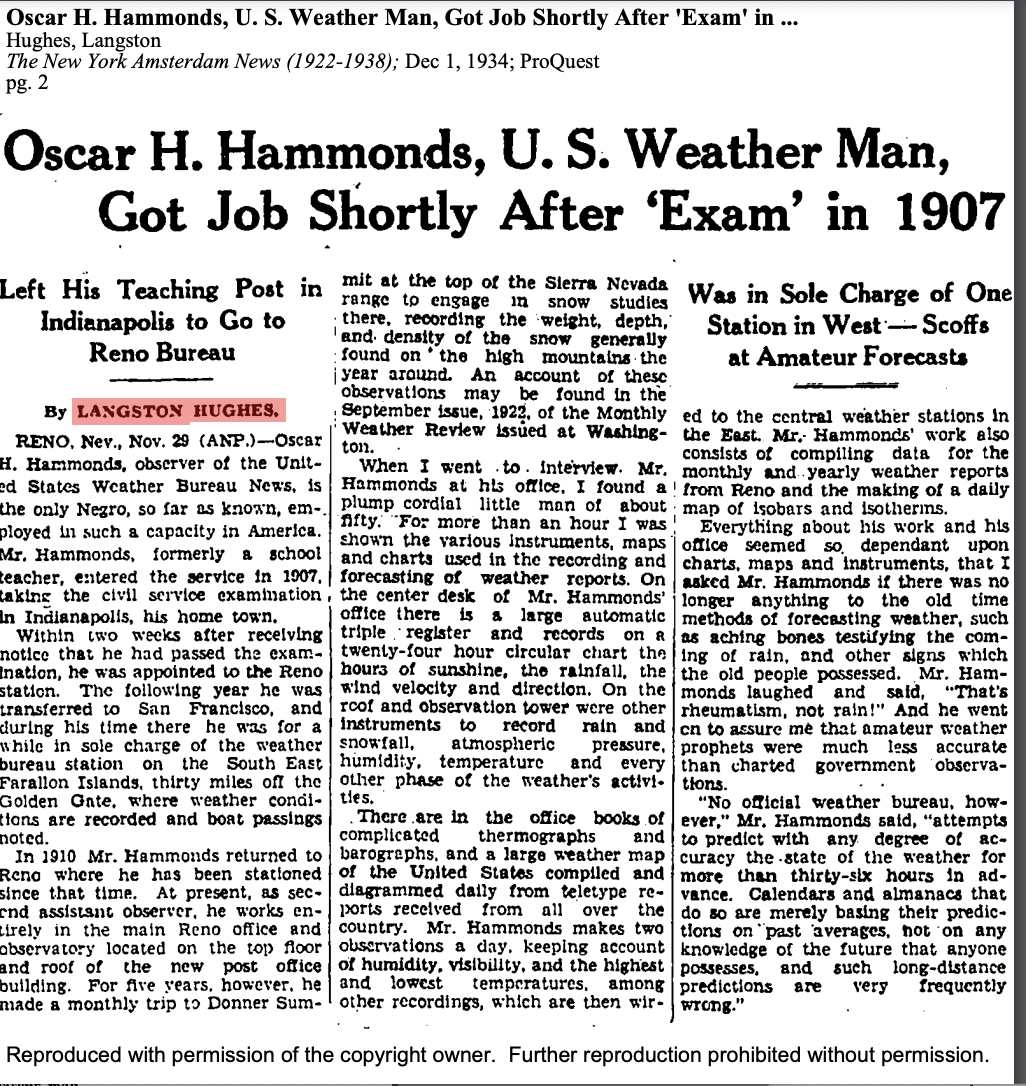
This article was widely distributed via the Associated Negro Press. The headline writer for one paper, the Norfolk New State Journal–didn’t read the story, however: “Divorce Mart Claims Only Negro Weatherman in US; ‘Discovered by Poet Hughes'”; its copy is exactly as distributed by ANP.
Oscar Hammonds was one of early Reno’s most remarkable Black citizens. He was President of the NAACP when it organized, in 1919, the first in the state of Nevada, and he was Bethel AME’s caretaker in many senses of the word for decades. In reports from Reno published in the Chicago Defender, the social activities of him and his wife, Mabel, are noted as many times as anyone’s. He helped organize the Progressive Club in 1922 (later changed to the Criterion Club) to raise funds for the church; he chaired its entertainment committee and helped organize smokers and dances, some of which featured the Hammonds Harmony Four. She helped organize the Women’s Mite Missionary society, which often met at their home, at 537 E. Scott Street. To raise funds for new church pews, the Criterions hosted Mme. Anita Patti Brown, Black Patti, in a 1923 “musical treat seldom enjoyed by the people of this city.” He was also president of the Booker Washington Forum.
As weather observer, he wrote countless summaries and predictions that were distributed throughout the western region, rarely with a byline, but if collected, his would represent a sizable body of publications. He surely should be included in any list of Nevada authors.
The Hammonds Harmony Four entertained frequently and starred in at least three productions of Ethiopia at the Bar of Justice. As late as 1941, he was a trustee at Bethel AME, helping to raise funds for renovations; church records indicate that he often contributed the requisite amount of money needed to balance its books.
Mabel Hammonds and her sister, Mrs. Alberta Jones, hosted a birthday dinner for their mother, Mrs. Louise la Barriere of New Orleans, in July 1933.
Nov 16
Left tonight for Frisco. Bill Allen’s birthday, wine drinking party.
Hughes did not return to Reno.
• • •
–March 3, 2025
